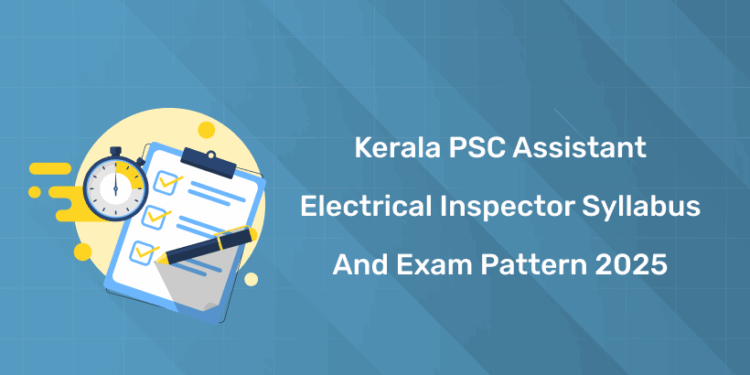Table of Contents
The Kerala PSC Assistant Electrical Inspector syllabus 2025 has been officially released in August 2025. Aspirants can now start their preparation using the updated syllabus and exam pattern. Covering key topics like Electric Circuits, Power Systems, Digital Electronics, and Control Systems, this guide helps you stay ahead with the latest syllabus. Get the syllabus now!
Ace KPSC Technical Exams! JOIN NOW!
Kerala PSC Assistant Electrical Inspector Notification 2025 Highlights
| Particulars | Details |
| Name of recruiting organization | Kerala Public Service Commission (PSC) |
| Name of department | Kerala Electrical Inspectorate Department |
| Name of post | Assistant Electrical Inspector |
| Category Number | 96/2025 |
| Number of vacancies | As per Notification |
| Exam Date | November 14, 2025 |
| Admit Card | October 31, 2025 |
| Comfirmation Period | 23/08/2025 to 11/09/2025 |
| Mode of Exam | OMR 100 Marks |
| Medium | English |
| Official website | keralapsc.gov.in |
Kerala PSC Assistant Electrical Inspector Exam Date 2025
1: Between the period of 1858-1947, how many Viceroys ruled over India?
The Kerala PSC has announced the exam date for the Assistant Electrical Inspector – Direct Recruitment (Category No. 096/2025) under the Kerala Electrical Inspectorate Department. The statewide exam is scheduled to be held on November 14, 2025.
Candidates must complete their confirmation process between 23 August 2025 and 11 September 2025 to be eligible. The exam will be conducted in OMR mode, carrying 100 marks, in English medium, with a duration of 1 hour 30 minutes.
Prepare for Kerala PSC Technical Exams with Entri
സർക്കാർ ജോലി എന്ന സ്വപ്നം ഇനി സ്വപ്നം മാത്രമല്ല! Join Kerala's Top-rated PSC Coaching Programs
Join NowKerala PSC Assistant Electrical Inspector Study Notes 2025 – Subject Wise
The Kerala PSC Assistant Electrical Inspector notes have been carefully prepared by our subject experts in line with the latest syllabus. Covering all key subjects—Electrical Engineering concepts, circuits, machines, power systems, instrumentation, safety, and relevant general knowledge—they provide a concise yet comprehensive resource for exam preparation. Download now!
| Assistant Electrical Inspector | |
| Digital Electronics | |
| Thermodynamics Part 1 | |
| Thermodynamics Part 2 |
Kerala PSC Assistant Electrical Inspector 2025 Video Classes
Along with the study notes, specially curated demo class videos are provided based on the official syllabus. These sessions are handled by expert faculty, covering core Electrical Engineering topics, problem-solving approaches, and exam-focused strategies.
| Topic | Link |
|---|---|
| Units & Measurements | |
| Dimensional Analysis | |
| Motion – Part 01 | |
| Alphabet Series – Basic Concepts | |
| Alphabet Series Types – Based on Formation |
Kerala PSC Assistant Electrical Inspector 2025 Previous Question Paper
| Question Paper Category | |
| 075/2022 | |
| 117/2024 |
Prepare for Kerala PSC Technical Exams with Entri
സർക്കാർ ജോലി എന്ന സ്വപ്നം ഇനി സ്വപ്നം മാത്രമല്ല! Join Kerala's Top-rated PSC Coaching Programs
Join NowKerala PSC Assistant Electrical Inspector Admit Card 2025 Date
The admit card for the Kerala PSC Assistant Electrical Inspector – Direct Recruitment (Category No. 096/2025) exam will be released on October 31, 2025. Candidates can download their hall ticket from the official Kerala PSC website by logging in to their PSC profile using their User ID and Password.
The admit card will include key details such as the candidate’s name, roll number, exam venue, date, and reporting time. It is mandatory to carry a printed copy of the admit card along with a valid government-issued photo ID to the examination center. Candidates are advised to download the hall ticket well in advance and carefully read the instructions provided to avoid last-minute issues.
Kerala PSC Assistant Electrical Inspector Syllabus 2025 PDF Released
The latest Kerala PSC Assistant Electrical Inspector Syllabus 2025 has been officially released by the Kerala PSC in August 2025. Candidates preparing for the exam are advised to follow this updated syllabus and exam pattern to ensure effective preparation.
The syllabus covers core topics such as Electric Circuits, Power Systems, Digital Electronics, and Control Systems, along with other essential areas of Electrical Engineering. Aspirants can download the detailed syllabus directly from the official Kerala PSC website.
Kerala PSC Assistant Electrical Inspector Exam Pattern 2025
The official exam pattern for the Kerala PSC Assistant Electrical Inspector 2025 is yet to be released. Until then, candidates can follow the previous syllabus for preparation.
| Sl. No. | Topic | Marks |
|---|---|---|
| 1 | Electric Circuits | 10 |
| 2 | Magnetic Circuits – Absolute & relative permeability | 10 |
| 3 | DC Generators | 10 |
| 4 | Digital Electronics | 10 |
| 5 | Power Systems | 10 |
| 6 | Control Systems | 10 |
| 7 | Power Electronics | 10 |
| 8 | Measurements and Instrumentation | 10 |
| 9 | Signals and Systems | 10 |
| 10 | Transducers | 10 |
Kerala PSC Assistant Electrical Inspector Syllabus 2025 Detailed
The official Kerala PSC Assistant Electrical Inspector syllabus 2025 has been released. Candidates can now prepare using the updated syllabus and exam pattern provided by the Commission. It covers core subjects relevant to the qualification for the post, and questions will be asked from these prescribed areas. Aspirants are advised to thoroughly go through the official syllabus to ensure focused preparation.
1.Electric Circuits
Kirchoff’s laws – maximum power transfer theorem. Star/delta transformation. Energy stored in a capacitor and inductor. Analysis of coupled circuits – dot polarity convention – sinusoidal steady state analysis of coupled circuits. Generation of alternating voltages and currents – rms value, average value, peak factor, form factor. AC through series R, L, C circuit – series resonance- resonant power – bandwidth. Resonance in parallel circuits.
2.Magnetic Circuits
Absolute and relative permeability of a medium Magnetic field strength- magnetic potential. Relation between magnetism and electricity – Series and parallel magnetic circuits with composite materials. Faraday’s laws of electromagnetic induction- Lenz’s law – statically and dynamically induced emf.
3. DC Generators
Constructional details, working principle – types of dc generators – emf equation – power stages – condition for maximum efficiency. DC motor – armature control and field control. Single phase transformer – working principle, equivalent circuit, losses in a transformer, condition for maximum efficiency. Three phase transformer construction- difference between power transformer and distribution transformer. Alternators- constructional details –Synchronous motor – starting methods – synchronous condenser. Three phase induction motor – working principle, constructional details – slip, torque and current equations – torque- speed curve.
4. Digital Electronics
Number Systems and Codes: Binary, Octal and hexadecimal conversions- ASCII code, Excess -3 code, Gray code. Combinational circuits – Adders – Full adder and half adder. Multiplexers- Demultiplexers. Flipflops – registers – counters. Digital – to – Analogue and Analogue-to-Digital conversion. Microprocessors – Internal architecture of 8085 microprocessor–Functional block diagram Instruction set – Addressing modes – Classification of instructions – Status flags. Machine cycles and T states – Fetch and execute cycles- Timing diagram.
5. Power Systems
Line parameters -resistance- inductance and capacitance. Insulators –string efficiency – corona. Circuit breakers – rating- SF6 circuit breaker. Relays – types. Per unit quantities- symmetrical components – symmetrical and unsymmetrical fault. Power system stability – steady state, dynamic and transient stability-power angle curve.
6. Control Systems- (10 marks)
Transfer function of LTI systems – block diagram reduction – Signal flow graph – Mason’s gain formula – Type and Order of the systems- Characteristic equation Time domain specifications of transient and steady state responses- Impulse and Step responses of first order and second order systems. Static error coefficient type 0,1,2 systems. Routh’s stability criterion. Frequency domain specifications. Polar plot and Bode plot – concepts of gain margin and phase margin- stability analysis
7. Power Electronics
SCR- Structure, Static characteristics. Fully controlled and half controlled bridge rectifier with R, RL and RLE loads. Voltage Source Inverters– 1-phase half-bridge & full bridge inverter with R and RL loads – Pulse width modulation. Single quadrant, Two quadrant and Four quadrant chopper. Operational Amplifiers – fundamental differential amplifier – Modes of Operation. Properties of ideal and practical Op-amp – gain, CMRR and slew rate.
8. Measurements and Instrumentation
Measurement standards – errors – Types of Errors. Classification of instruments, secondary instruments–indicating, integrating and recording. Ammeters and voltmeters – moving coil, moving iron. Measurement of power: Dynamometer type wattmeter –Construction and working – 3- phase power measurement. Measurement of energy – Single phase energy meter – construction and working. Digital Energy meters -Time of Day(TOD) meters. Oscilloscopes- principle of operation of general purpose CRO-basics of vertical and horizontal deflection system.
9. Signals and Systems
Classification of signals – Elementary signals- Basic operations on continuous time and discrete time signals. Concept of systems – Classification of systems- Properties of systems – Time invariance- Linearity -Causality – Memory – Stability. Sampling process – Impulse train sampling – sampling theorem- Aliasing effect. Zero order and First order hold circuits.
10. Transducers
General classification- LVDT- angular displacement transducers- hall effect transducers. Batteries – Primary cells– secondary cells- battery ratings- grouping of cells. Wiring – systems of wiring- rules for domestic wiring. Earthing- types of earthing – rules for earthing. Illumination – Laws of illumination. Electric lamps –
different types.
How to Download KPSC Assistant Electrical Inspector Syllabus 2025
Go to the Kerala PSC website → Click on “Recruitment” → Select “Post Wise Syllabus” → Find “Assistant Electrical Inspector” → Click “Download”.










